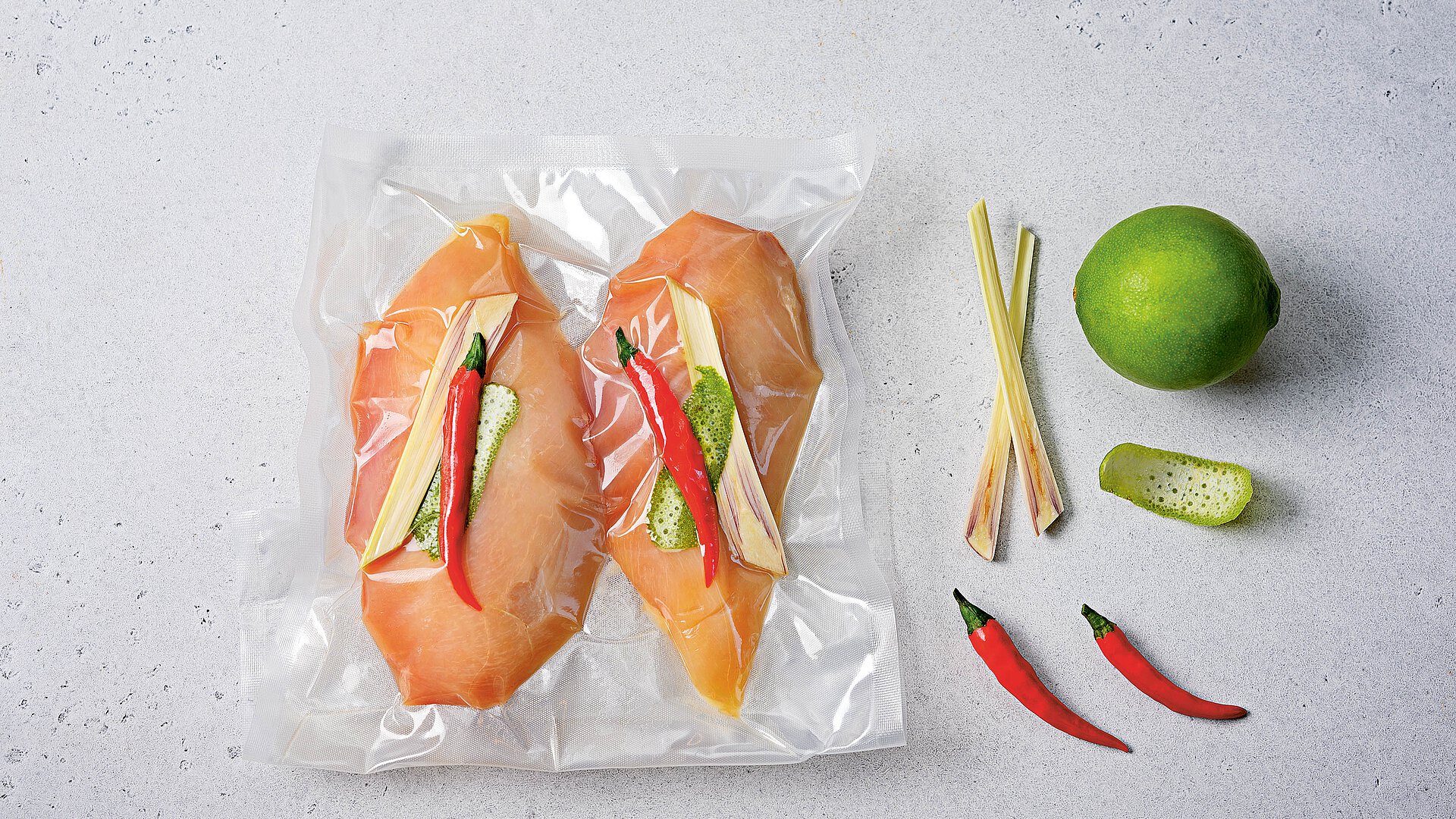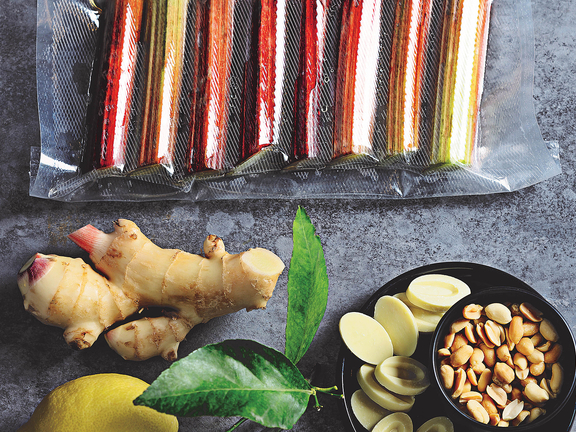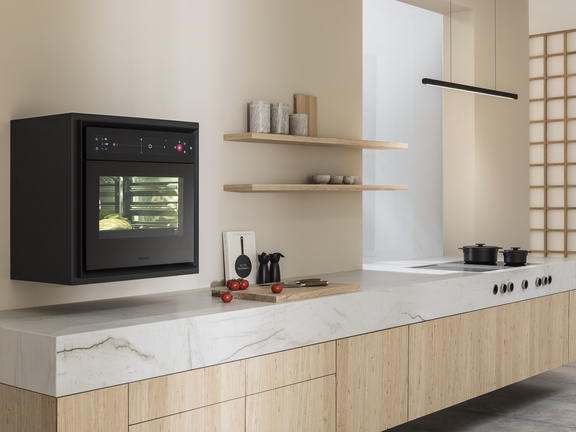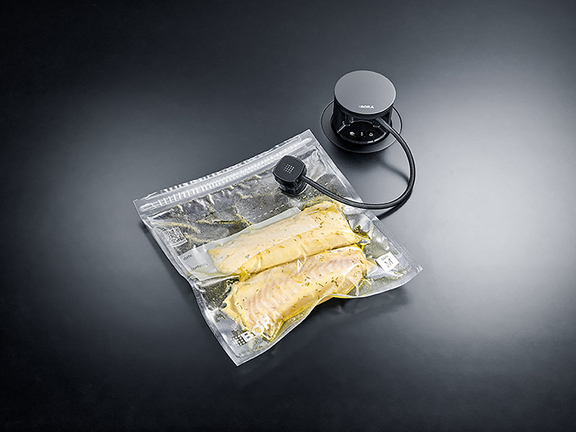

Sous-vide cooking is a temperate way of cooking meat, fish and vegetables. The term comes from French and literally means ‘under vacuum’. This describes the method accurately: when cooking sous-vide, you vacuum-seal the ingredients and cook them in a bain marie or steam at low temperatures. Depending on the ingredients, the food in its airtight packaging takes from about one to 24 hours to cook and the results are astounding. Due to the low heat and the gentle cooking process, you can enjoy intense flavours and look forward to the optimum amount of nutrients. We reveal how you can cook vegetables, fish and meat sous-vide.
We have known since the end of the 18th century that we don’t necessarily need high temperatures to cook. The first to test this was physician Benjamin Thompson in 1799 using warm air to cook. To do this, he put meat in a machine that was originally designed to dry food. After a few hours, he was surprised to find that the meat was perfectly cooked and tasted delicious.

However, it took several hundred years until the method of cooking at low temperatures took hold. In the 1960s, vacuum sealing became popular as a preservation method and, in the mid 70s, French and American chefs rediscovered cooking under a vacuum and perfected it.
For a few years now, sous-vide cooking has been on the increase in private households. There are a number of reasons for this: For one, sous-vide cooking appliances are available to buy that stand out for their ease of use and can even be easily operated by amateur cooking enthusiasts. Another reason is that the word has spread that sous-vide cooking has wonderfully succulent, flavoursome results.
Sous-vide cooking requires just a few simple steps and a bit of time. First, you vacuum seal the ingredients, then you place them in a bain marie or steamer and set the desired cooking time. Now, you can sit back and relax or take care of other tasks in the kitchen until the cooking time is up. As soon as the food has reached its core temperature, it is kept constant. Finally, take the ingredients out and serve them up or use them to create a meal.
Not much heat but plenty of time:that’s the formula to guarantee irresistibly delicious results when cooking sous-vide. Whether you’re cooking vegetables or meat, all dishes are cooked to perfection. This is just one of the many advantages that make this cooking method so popular. You can also benefit from the following plus points:

Minimum effort: once vacuum sealed, food cooks in the bain marie without you having to do anything else. This gives you time for other things.
Perfect results every time: meat and fish stay tender, keep their typical flavours and don’t dry out.
Great for preparing in advance: the long cooking time makes precise meal planning possible and ingredients can be pre-cooked and reheated a day or two later.
Energy-saving: many sous-vide cooking appliances work on low power levels and so require less energy than a cooktop, for instance.
Different appliances are suited to cooking at low temperatures:
Important: Use bags that are specially designed for sous-vide cooking and remain fully airtight for long periods in the bain marie.
The core temperature and cooking time have a considerable influence on the results when cooking sous-vide. What’s more, in the case of meat and fish, the thickness of the food also plays its part. As a rule of thumb, when cooking meat sous-vide, the following applies: one centimetre requires a good hour of cooking time.
Good to know: even if the food stays in the water or steam for a long time, it will turn out perfectly. Technically, it is not possible to overcook food when using the sous-vide method. What’s more important is the minimum time so that you can look forward to perfect results. So, how long should different ingredients be cooked sous-vide? The table below will guide you:
| Ingredient | Desired done level | Core temperature | Cooking time |
| Beef | Medium rare | 50-55 °C | approx. 60 min. |
| Medium | 55-57 °C | approx. 60 min. | |
| Medium to well | 57-60 °C | approx. 60 min. | |
| Chicken | - | 70 °C | approx. 90 min. |
| Lamb (fillet) | Medium rare | 52-55 °C | approx. 40 min. |
| Medium | 55-60 °C | approx. 40 min. | |
| Medium to well | 60-65 °C | approx. 40 min. | |
| Fish (e.g. salmon) | Transculent | 38–40 °C | approx. 30 min. |
| Flaky | 45–45 °C | approx. 30 min. | |
| Firm | 42–50 °C | approx. 30 min. | |
| Well done | 46–55 °C | approx. 30 min. |
Important: chicken can also be cooked sous-vide at temperatures below 70 °C. However, to prevent the risk of salmonella, you should sear it briefly before serving.
The times refer to meat and fish portions that are one to two centimetres thick. Thicker pieces require a longer cooking time accordingly.
You can also cook vegetables sous-vide with the following cooking times and core temperatures:
Vegetable variety | Core temperature | Cooking time |
| Artichokes | 85 °C | approx. 50 min. |
| Cauliflower | 85 °C | approx. 40 min. |
| Chicory | 85 °C | approx. 60 min. |
| Fennel | 85 °C | approx. 50 min. |
| Carrots | 85 °C | approx. 60 min. |
| Beetroot | 85 °C | approx. 60 min. |
Asparagus (white) | 85 °C | approx. 75 min. |
Asparagus (green) | 85 °C | approx. 40 min. |
Onions | 85 °C | approx. 50 min. |

Ingredients cook slowly and gently with the sous-vide method. However, this method does not produce any fond. You can conjure this up in a flash afterwards: If you wish to cook steaks sous-vide, briefly sear the meat after sous-vide cooking to create a delicious fond.
If you want to store food for longer after sous-vide cooking, cool it down as quickly as possible by plunging it in ice-cold water for a few seconds, for instance. This stops the cooking process and prevents germs from multiplying.
Sous-vide cooking is a method by which food is vacuum-sealed and then cooked at low core temperatures in a bain marie or steam.
Virtually all meat and fish varieties and many kinds of vegetables are suited to sous-vide cooking. The only exception is soft varieties like tomatoes. Poultry must be cooked through, for instance, by briefly searing it before serving.
You should ideally add herbs and spices to the vacuum bag, where they will keep their flavour perfectly.
If you have a steam oven on which you can precisely control the temperature, it is possible. To ensure perfect results, it’s important to cook sous-vide on a low heat at a stable temperature.
Sous-vide cooking in a steamer is a popular alternative to the bain marie. The following also applies here: the appliance should allow for low temperatures that can be precisely controlled.
To cook sous-vide, you need a vacuum sealer, the corresponding bags and an appliance for cooking sous-vide (steam oven, steamer or sous-vide stick).
Vacuum sealing ensures that the food is airtight when packaged. It does not come into contact with water or steam and neither liquid nor flavours can escape. This achieves succulent, flavoursome results.